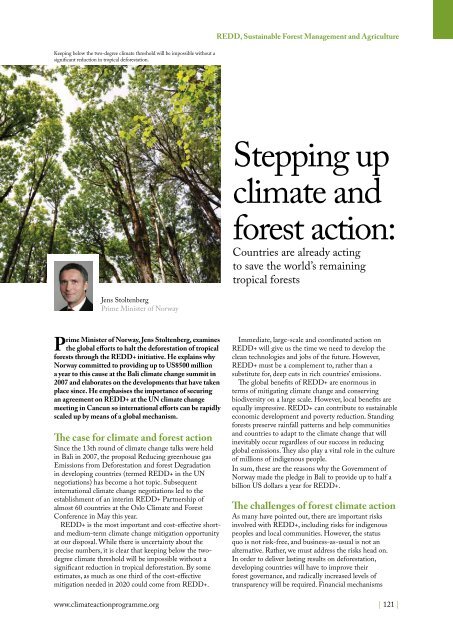Climate Action 2010-2011
You also want an ePaper? Increase the reach of your titles
YUMPU automatically turns print PDFs into web optimized ePapers that Google loves.
Redd, Sustainable Forest Management and Agriculture<br />
Keeping below the two-degree climate threshold will be impossible without a<br />
significant reduction in tropical deforestation.<br />
© Creative commons/flickr/keepitsurreal<br />
Stepping up<br />
climate and<br />
forest action:<br />
Countries are already acting<br />
to save the world’s remaining<br />
tropical forests<br />
Jens Stoltenberg<br />
Prime Minister of Norway<br />
Prime Minister of Norway, Jens Stoltenberg, examines<br />
the global efforts to halt the deforestation of tropical<br />
forests through the Redd+ initiative. He explains why<br />
Norway committed to providing up to US$500 million<br />
a year to this cause at the Bali climate change summit in<br />
2007 and elaborates on the developments that have taken<br />
place since. He emphasises the importance of securing<br />
an agreement on Redd+ at the UN climate change<br />
meeting in Cancun so international efforts can be rapidly<br />
scaled up by means of a global mechanism.<br />
The case for climate and forest action<br />
Since the 13th round of climate change talks were held<br />
in Bali in 2007, the proposal Reducing greenhouse gas<br />
Emissions from Deforestation and forest Degradation<br />
in developing countries (termed REDD+ in the UN<br />
negotiations) has become a hot topic. Subsequent<br />
international climate change negotiations led to the<br />
establishment of an interim REDD+ Partnership of<br />
almost 60 countries at the Oslo <strong>Climate</strong> and Forest<br />
Conference in May this year.<br />
REDD+ is the most important and cost-effective shortand<br />
medium-term climate change mitigation opportunity<br />
at our disposal. While there is uncertainty about the<br />
precise numbers, it is clear that keeping below the twodegree<br />
climate threshold will be impossible without a<br />
significant reduction in tropical deforestation. By some<br />
estimates, as much as one third of the cost-effective<br />
mitigation needed in 2020 could come from REDD+.<br />
Immediate, large-scale and coordinated action on<br />
REDD+ will give us the time we need to develop the<br />
clean technologies and jobs of the future. However,<br />
REDD+ must be a complement to, rather than a<br />
substitute for, deep cuts in rich countries’ emissions.<br />
The global benefits of REDD+ are enormous in<br />
terms of mitigating climate change and conserving<br />
biodiversity on a large scale. However, local benefits are<br />
equally impressive. REDD+ can contribute to sustainable<br />
economic development and poverty reduction. Standing<br />
forests preserve rainfall patterns and help communities<br />
and countries to adapt to the climate change that will<br />
inevitably occur regardless of our success in reducing<br />
global emissions. They also play a vital role in the culture<br />
of millions of indigenous people.<br />
In sum, these are the reasons why the Government of<br />
Norway made the pledge in Bali to provide up to half a<br />
billion US dollars a year for REDD+.<br />
The challenges of forest climate action<br />
As many have pointed out, there are important risks<br />
involved with REDD+, including risks for indigenous<br />
peoples and local communities. However, the status<br />
quo is not risk-free, and business-as-usual is not an<br />
alternative. Rather, we must address the risks head on.<br />
In order to deliver lasting results on deforestation,<br />
developing countries will have to improve their<br />
forest governance, and radically increased levels of<br />
transparency will be required. Financial mechanisms<br />
www.climateactionprogramme.org | 121 |












